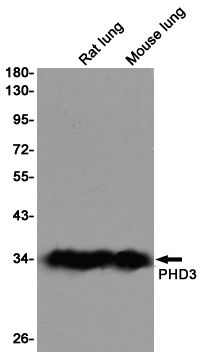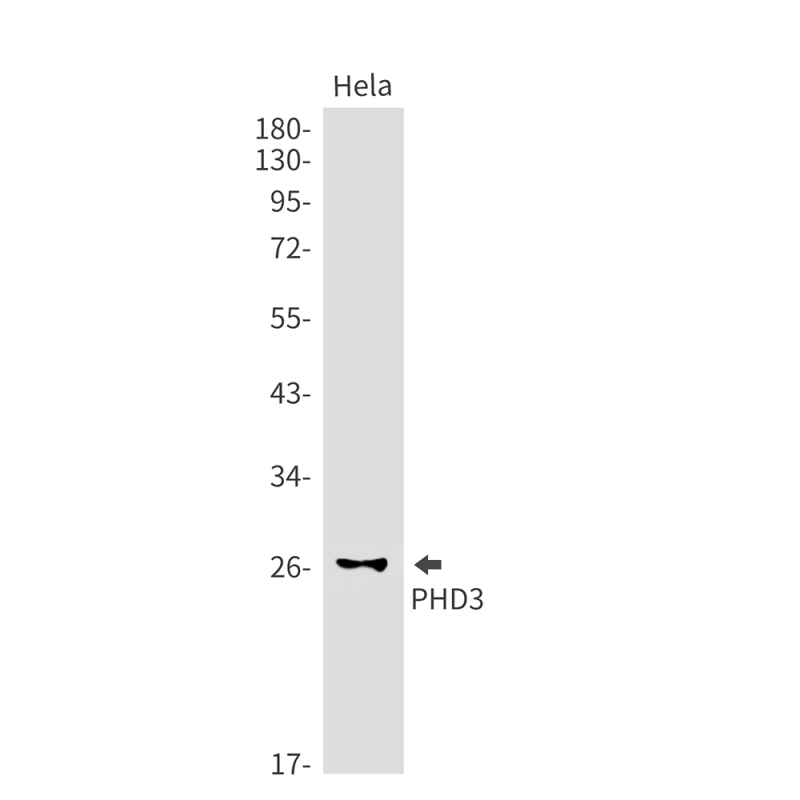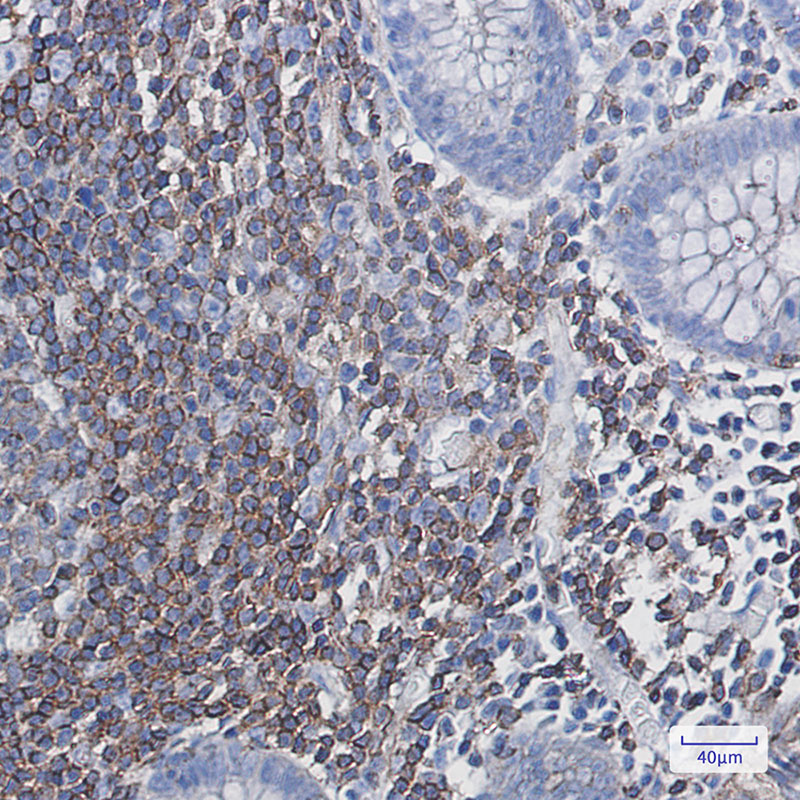


| WB | 1/500-1/1000 | Human,Mouse,Rat |
| IF | 1/20 | Human,Mouse,Rat |
| IHC | 1/50-1/100 | Human,Mouse,Rat |
| ICC | 技术咨询 | Human,Mouse,Rat |
| FCM | 咨询技术 | Human,Mouse,Rat |
| Elisa | 咨询技术 | Human,Mouse,Rat |
| Aliases | PHD3; HIFPH3; HIFP4H3 |
| Entrez GeneID | 112399 |
| WB Predicted band size | Calculated MW: 27 kDa; Observed MW: 27 kDa |
| Host/Isotype | Rabbit IgG |
| Antibody Type | Primary antibody |
| Storage | Store at 4°C short term. Aliquot and store at -20°C long term. Avoid freeze/thaw cycles. |
| Species Reactivity | Human,Mouse,Rat |
| Immunogen | Recombinant protein of human PHD3 |
| Formulation | Purified antibody in TBS with 0.05% sodium azide,0.05%BSA and 50% glycerol. |
+ +
以下是关于PHD3抗体的3篇参考文献摘要示例(文献名称及内容为虚构,供参考):
1. **文献名称**:*PHD3 Antibody Development for Hypoxia Imaging in Tumors*
**作者**:Smith A, et al.
**摘要**:本研究开发了一种高特异性PHD3单克隆抗体,验证了其在肿瘤缺氧微环境中的检测能力,证实PHD3表达与HIF-1α降解相关,为癌症诊断提供潜在工具。
2. **文献名称**:*Role of PHD3 in Ischemic Injury: Insights from Antibody-Based Inhibition*
**作者**:Chen L, et al.
**摘要**:通过抗PHD3抗体阻断其羟化酶活性,发现其可减轻心肌缺血再灌注损伤,机制与HIF-2α稳定及抗氧化通路激活有关。
3. **文献名称**:*PHD3 Antibody Validation in Neurodegenerative Disease Models*
**作者**:Garcia R, et al.
**摘要**:利用新型PHD3多克隆抗体证实,脑缺血模型中PHD3上调促进神经元凋亡,抗体抑制后显著改善神经功能,提示其治疗潜力。
---
如需真实文献,可参考以下关键词搜索:
- **PHD3/EGLN3抗体应用**:查找涉及Western Blot、IHC的实验文献。
- **PHD3功能研究**:关注其在缺氧、代谢或疾病中的机制论文。
- **抗体开发论文**:检索生物技术期刊中抗体特异性验证相关研究。
The PHD3 (Prolyl Hydroxylase Domain-containing protein 3) antibody is a key tool for studying the oxygen-sensing pathway and hypoxia-related cellular responses. PHD3. encoded by the EGLN3 gene, belongs to a family of iron- and 2-oxoglutarate-dependent dioxygenases that regulate the stability of hypoxia-inducible factors (HIFs). Under normoxic conditions, PHD3 hydroxylates specific proline residues on HIF-α subunits, marking them for proteasomal degradation via the von Hippel-Lindau (VHL) ubiquitin ligase complex. This process is suppressed in hypoxia, allowing HIF-α accumulation and activation of genes involved in angiogenesis, metabolism, and cell survival.
PHD3 antibodies are widely used in research to detect endogenous PHD3 expression levels, localization, and post-translational modifications in tissues or cultured cells. They enable techniques like Western blotting, immunohistochemistry, and immunofluorescence, aiding investigations into hypoxia signaling in cancer, ischemic diseases, and metabolic disorders. Studies also explore PHD3's non-canonical roles in apoptosis, mitochondrial function, and neuronal differentiation. Commercial PHD3 antibodies are typically validated for specificity using knockout controls or siRNA-mediated knockdown. Researchers often pair them with HIF-1α/2α antibodies to analyze the dynamic interplay between oxygen sensors and their targets. Optimal performance depends on proper sample preparation, as PHD3 activity and stability are influenced by cellular oxygen tension and iron availability.
×